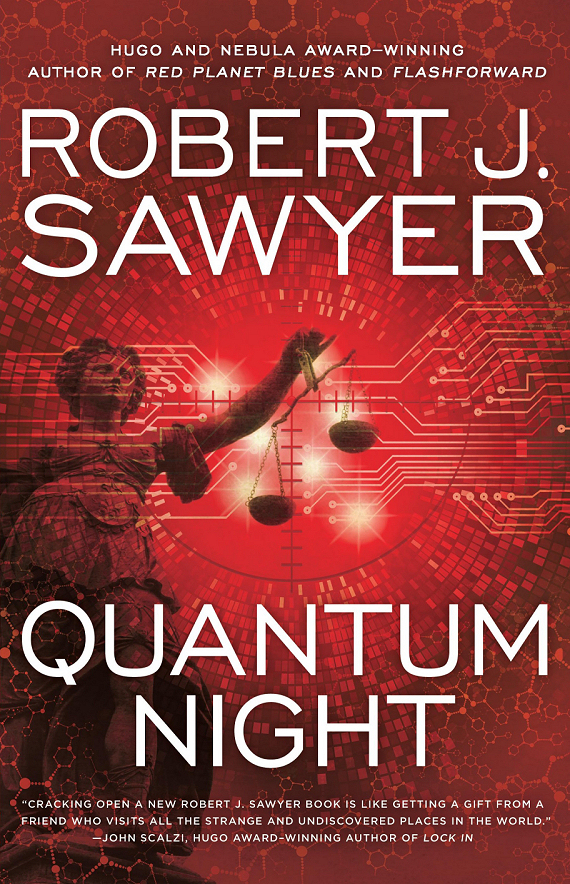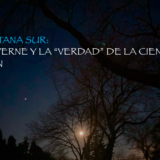
Poisson d’Avril! (That’s the only April Fool’s Day joke you’ll see from this column today. Why is it April Fish in French? Only the French know for sure!) But today’s column is serious, however: first we’re going to talk about Canada’s equivalent to the Hugo Award: the Aurora Award. Then, we’re going to talk about Robert J. Sawyer’s new novel, Quantum Night. The Aurora Award was originally called the Casper Award, but there were people who thought it was the Friendly Ghost award—plus, if you Google it, there are several different awards named Casper—so it was changed. The Aurora is given out annually at Canvention, the Canadian National Convention—which is held in conjunction with a different convention every year—in eight professional categories and four fan categories. This year’s voting for the Auroras will begin on June 15 and run through July 23, with the Auroras being given out at When Words Collide/Canvention in Calgary, Alberta on August 12-14. It only costs $10 for a year’s membership to CSFFA, the Canadian Science Fiction and Fantasy Association, and that $10 gets you the “voters’ packet,” which usually includes ebook versions of a majority of that year’s nominees—so that the electorate for the CSFFA is able to vote fully informed (rather than just voting for someone because you know that person’s name or she’s your spouse’s second cousin or something). That’s a huge value for only $10. Coincidentally, I can now announce that both my wife, the Beautiful and Talented Lynne Taylor Fahnestalk (two-time Aurora winner!), and I are Aurora Award nominees. Lynne is nominated for “Body of Work (2015)” in the Artist category, and I’m nominated in the Fan Related Work category for this column. (Because of previous nominations we already have our “nominee” pins—Figure 1.) Thanks to all who nominated us, and good luck to all nominees! (Am I the only person who hears the Muppets singing “Mahna Mahna” when they see the “nominee” word?)

And also coincidentally, there is now—for a limited time; I think maybe only two weeks—an Aurora Award Storybundle for sale! If you remember the last couple of Storybundles I promoted in this column—and I don’t get a payoff or kickback on these, I promise!—it’s a deal wherein you can buy a number of ebooks for as little as $5 (to get the minimum number of five ebooks); but if you pay over $15 for the bundle, you wind up (see Figure 2) with ten ebooks by Aurora winners and finalists! (Oy, such a deal!) While only Canadians (and people who live in Canada) can join CSFFA and get the voters’ packet, anyone in the world can buy the Aurora Award Storybundle. Here’s what’s being offered in this Storybundle, curated by three-time Aurora Award winner Douglas Smith:
Nobody’s Son by Sean Stewart
Cagebird by Karin Lowachee
Gifts For the One Who Comes After by Helen Marshall
Blood and Water by Hayden Trenholm
Pattern Scars by Caitlin Sweet
If you pay more than the bonus price of just $15, you get all five of the regular titles, plus five more:
The Tattooed Witch by Susan MacGregor
Starplex by Robert J. Sawyer
West of January by Dave Duncan
Chimerascope by Douglas Smith
Black Wine by Candas Jane Dorsey
So if you like SF/F, and you’re even the least bit curious about Canadian SF/F, this is your chance—Americans, Canadians, even Europeans!—to get a bunch of great, DRM-free(!) SF/F books that have either won or been finalists for the Aurora Award!

Who’s Robert J. Sawyer? Well, if you’ve been living in a cave, you might not know that Rob Sawyer is one of the world’s most award-winning science fiction writers; he’s won the Hugo, the Nebula, the Skylark and the John W. Campbell Memorial awards in the U.S., and multiple Auroras (and the Aurora Lifetime Achievement—see Figure 3) in Canada, plus he’s had a major TV series (FlashForward) based on his novel of the same name. And the Aurora may well come to his new novel (next year), of which we’ll speak more in a moment. He’s also been given two honourary doctorates (one an LLD, one a LittD) by two different universities. And the list goes on. If you click on the link above, check out his C.V., which goes on practically forever. He lives in Toronto, and is married to Carolyn Clink, Aurora Award-winning poet. On Wednesday of this week, I went to a reading on his current book tour for Quantum Night. He was, as always (it’s amazing, considering he’s been on the road since March 2, and has to be bone-tired!) an engaging speaker, and during the Q&A session after his reading, always addressed his questioners in the audience by name (he learned and remembered the names while signing autographs beforehand).
But that’s all about Sawyer the man and the writer (and, as I believe Tom Lehrer once said, “idol of gibbering millions in Madagascar”)—what about the new book? Well, I’m pleased to tell you that this is one “hard SF” book that manages to throw in large information dumps without boring the reader! The information—and one thing Rob Sawyer is well known for—is necessary to the plot, and extremely well researched, but somehow (and this is a very rare thing) manages to keep the reader alert and involved with the story. So what’s it about? I could say it’s about human consciousness, neurology, psychology, sociology, quantum mechanics, the world today and the world tomorrow… but that wouldn’t tell you much of anything about the book. Okay, here’s the setup: A professor at the University of Manitoba, Jim Marchuk, lecturer on “The Neuroscience of Morality,” is called to Atlanta, Georgia to help the defense for a killer ex-prison guard named Becker—his defense is going to be that he is a psychopath, and can’t help himself. Becker claims that psychopathy is a medical condition and, as such, a mitigating factor. Now, to us “neurotypicals,” as we’re (at least, I’m one, and I’m assuming you readers are too) called, that sounds like a ridiculous defense. Sort of like the guy who kills his parents asking the jury for lenience on the grounds that he’s an orphan.
There’s a test, the Hare Psychopathy Checklist, Revised (commonly called the PCL-R) that is generally accepted to—under proper psychiatric supervision and when interpreted by a qualified person—determine whether any given subject is a psychopath. There is a maximum number of points (40) and, if anyone scores 30 points (25 in the U.K.), they are called a psychopath. (Marchuk says there is no difference between a sociopath and a psychopath; they’re the same thing. There are also different kinds of sociopath besides the killer and career criminal types: the person who thinks only of him/herself and has no empathy for other people’s pain is one.) On the witness stand, Prof. Marchuk is revealed to have a blanked-out part of his past that he can not access; his testimony is—for other reasons—discredited and Becker sentenced to death. It is while Marchuk is searching for the key to his past that he discovers another key indicator for psychopathy; a physiological indicator that cannot be faked, and that gives an infallible answer as to whether a subject is a psychopath.

And into this mix we add what happened during Jim Marchuk’s “blank” period—it’s possible that he did some terrible things—and his “once-upon-a-time” university girlfriend, Kayla Huron, who is now a quantum physicist, plus his one-time teacher and now colleague, the blind professor Menno Warkentin. Kayla has discovered some things about quantum superposition—the idea that some atoms can be in multiple states at once—and human intelligence. (Schrödinger’s cat is one example of superposition—the idea that by observing an object its state becomes fixed, whereas previous to observation it can be in multiple states.) Stir all that together in the cauldron of human experience—the fact that a mindless wave of fear and violence seems to be sweeping the Earth (look at what’s happening right now with certain Presidential candidates and in certain states, plus the so-called Islamic State and the Levant, as well as Boko Haram and other extremist movements).
Another thing about Marchuk is that his actions during his blanked-out period indicate true psychopathy, yet he has applied his own, infallible new test to himself, and he is not a psychopath. Marchuk himself is a vegan and is deeply concerned with what’s called “utilitarianism”—the idea expressed by Spock in Star Trek—The Wrath of Khan, when he says “the needs of the many outweigh the needs of the few, or the one.” (Oddly enough, I first read that as “unitarianism”—an entirely different thing; when I realized, a few pages later that I had misread it, it changed the whole tone of the book!) Since Jim Marchuk is, by test and by definition, not a psychopath, how could he have changed, and what are the implications for the world at large?
The philosophical focus of the book is summed up—and maybe dismissed—in the simple statement voiced by one of Marchuk’s students: “You can’t change human nature.” But what if you could? Rather than a dry discussion on these philosophical points, Quantum Night takes you on an exciting ride through a scientific extrapolation in the near-future time of 2020—only four years away from now—when the US has a new President who seems not to share the conciliatory nature of Barack Obama; when Justin Trudeau’s government is only surviving through a coalition with the NDP (Canadians will understand what that means), and where the entire world seems to be falling into a crevasse of mindless violence where the highest mentality is mob mentality.
The great thing about this book is that it makes you want to follow up on all those things mentioned by Sawyer: what are “microsaccades,” is quantum superposition a real force in neurology (evidence so far says, “not really,” but all the evidence isn’t yet in); what does it mean to be “neurotypical”? I don’t know about all of you, but after reading this I spent a couple of days with Google, tracing down paper after paper to find out what’s real and what’s extrapolation. This is some exciting writing! This book will be a strong contender for the Aurora Award next year.
It’s available in hardcover from Amazon, as an ebook and, as always, from your local bookstore, whether an independent or a chain (though I urge you to go independent rather than chain). Get it today; you won’t be sorry!
Please comment on this week’s column if you have anything at all to say. You can comment here (once you’ve logged in); or you can comment on my Facebook page, or in the Facebook groups where I publish a link to this column. I welcome all comments, good or bad. Don’t feel you have to agree with me to post a comment, either. As always my opinion is my own, and doesn’t necessarily reflect the views of Amazing Stories or its owners, editors, publishers or other bloggers. See you next week!
Editor’s note: Congratulations to both Steve and Lynne Taylor Fahnestalk for their Aurora Nominations!











I started out being very impressed and intrigued by the premise of this story. I liked the way Sawyer takes the Penrose-Hameroff hypothesis and runs with it: the idea that people’s consciousnesses could be flipped, changing their nature, puts a whole new spin on things! There are strange things done in the midnight sun and by the time I was halfway through, I was thoroughly hooked. The story rocked along. The fatal flaw arrived, however, with the conflating of the original premise with the not very scientific social construct of the sociopathology of psychopaths. Similarly, the three classifications of psychological types seem more phrenology that modern science, a case of Psychopomorphism, attributing half-baked psychological theories to humans, just not plausible and too close to the nonsense of The Bell Curve. Including a reading list at the end suggests Sawyer wants us to take it all seriously. Oh, please. There is a great story in here but, unfortunately, it got lost in the telling.
Gee, Rob, don’t hold back… tell us how you really feel. You are, of course, welcome to your opinion. I don’t know enough psychology to know whether “the three classifications of psychological types seem more phrenology [than] modern science.” I’d like to know where your expertise comes from; expertise–rather than opinion, which is never in short supply–is sorely needed these days! Thanks for your comment.